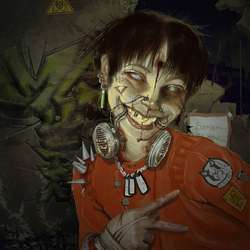Recording under the guise of Alexeï Kawolski, Montreal-based composer and producer Alexis Langevin-Tétrault walks the line between making harsh and abstract material and more noticeably melodic compositions. Kawolski has built up quite a library of releases since the late 2000s and was nominated in 2013 for a Quebec Indy Award for best experimental album. That fact alone should provide some idea of how different Kawolski’s work is from the usual, increasingly tiresome array of EDM releases which more and more seem designed to appeal primarily to drug-ingesting festival-goers than to more discriminating listeners. Even if Kawolski trades in the same scratchy and glitched-out sonic currency as an album like SD Laika’s That’s Harakiri, his music seems fairly approachable and consistently inventive.
The opening track of Kawolski’s 2014 album My DC Offset Fields is titled “Wake Up Now” and it indeed does demand that a listener do just that, awash in loud and heavy accents of percussive sounds that swirl in the mix. The album continues with “Cloud Sculpture” which imagines what a horror movie soundtrack made by Richard D. James might sound like. More immediately musical than its predecessor since it has throbbing keyboard droning away underneath the prevalent clutter of noise, it nonetheless isn’t until fourth track “Spliced Life” that Kawolski unveils something that’s definitively melodic. Built around a bloopy and playful keyboard progression and bouncy synthesized bass, the track climaxes in a less aggressive assault of rhythmic zips and zaps. “MK ULTRA” (named after an American government mind control program) soldiers along to a repetitive and trudging beat, while “Broken Child” lets loose with a fuzzy but melancholic synthesizer tune of the type I’d typically associate with Boards of Canada. The soaring, flute-like theme that pops up around the halfway point cements this track as the most inviting and undeniably pleasant thing here.
As the album starts to wind down, we get “Pure Data broken patch,” as cold and calculating a track as that title suggests. Never introducing even a sliver of definable melody, the piece is constituted almost exclusively of beeps, snaps, and clicks with a metallic whirring heard in the background. Though it has a very mechanical feel to it, “Hangar 609” offers up another cheerful keyboard line as its focal point, but any sense of hope provided is all but eliminated by the brief ”Bartonella Henselae” that follows it. With ominous droning chords (think the opening of Kubrick’s The Shining) and high-pitched screeches, this is probably the most unsettling thing one will hear on the album: the more substantial but quirky “You Get So Along at Times That It Just Makes Sense (ready to self-destruct)” can’t do much to entirely alleviate feelings of dread before the album concludes with the short and quiet “Désintégration.”
Kawolski has described his music as an attempt to find beauty in darkness, and that notion is quite evident throughout My DC Offset Fields. There’s a frigid quality to much of this music, yet that iciness ensures that the moments when gorgeous melodies shine through the gritty noise elements are all the more striking. Much as is the case with classic Aphex Twin albums, Fields is full of weird sounds galore, flatulent rhythm elements, and an occasionally overpowering mass of clipped noise, demonstrating an intricate production style in which every blip, bloop, crack, clack, or snap seems precisely placed. This sense of craftsmanship is refreshing when compared to a substantial amount of today’s electronic music which seems to have been put together by producers who lack honest creativity or much of a sense of music fundamentals. Twelve tracks and 37 minutes in length, My DC Offset Fields probably isn’t something that would have mass appeal since it doesn’t even remotely have anything that I’d label as a dance track. Still, it’s a fine piece of creative work and nice representation of the talents of its creator.


Related news
1QI: Seven Sisters of Sleep, Dead Bars, Modest Midget, Alexeï Kawolski
Posted in Bands on February 23, 2015
Advertisement




